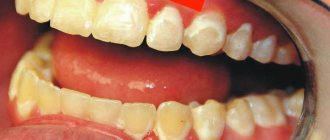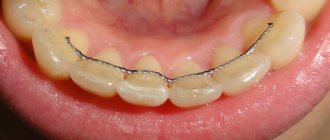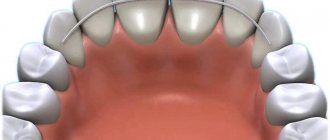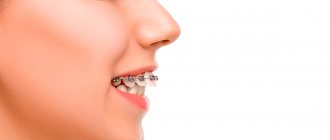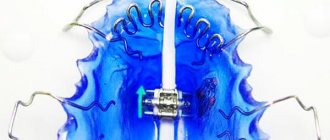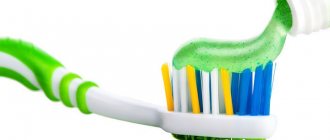24.10.2018
- The main causes of pain from braces.
- Feelings during installation of braces.
- What to do in the first week after installation?
- The last, painless stage in wearing braces.
8 tips: how to relieve pain from braces that will definitely help!
Braces and pain are inseparable. Orthodontic structures forcibly shift teeth from their usual position to the correct one. This process can sometimes be quite uncomfortable.
But it's not that scary. The most unpleasant sensations persist for the first few days. Their severity subsides as the patient gets used to the system. And if you know ways to alleviate the condition, creating a beautiful smile will be as convenient and painless as possible.
When is it necessary to get braces on your teeth?
Braces are installed to straighten teeth and correct abnormal bites. Orthodontic treatment with braces usually takes a long time, on average from 1.5 to 2 years. The essence of the treatment is that braces put pressure on the teeth, promoting their movement in the jaw. This process is accompanied by slow resorption of bone tissue in one place and its formation in another. Of course, such an intervention cannot be pleasant and often causes discomfort. Some people's teeth begin to ache, others feel only slight pressure without pronounced discomfort. This depends on a number of factors, but primarily on the individual characteristics of the body and the degree of orthodontic disorder. The stronger the curvature of the teeth, the more complex the malocclusion, the more likely it is that teeth hurt after braces. But possible pain is not a reason to refuse to correct a malocclusion, because it affects not only the aesthetics of your smile, but also your health. The functioning of the facial muscles and joints depends on the bite; problems with speech, diction, the respiratory system, and the cervical spine may arise. Therefore, correcting malocclusion is very important, even though braces can cause pain and discomfort.
The positive effect of orthodontic treatment far exceeds the inconvenience that the process of wearing braces brings.
What does pain mean?
Any pain while wearing braces indicates that pressure is being placed on the teeth. The process of bite correction involves not only soft tissue, but also bone tissue. It is changes in bone tissue that lead to unpleasant sensations, while soft tissues easily adapt to their new position.
It is important to know that there is nothing dangerous about this pain. This does not indicate destructive processes or inflammation, it only confirms the fact that the pathology has begun to be corrected.
There are a large number of nerve endings in the oral cavity, so it is almost impossible to completely get rid of discomfort. It can be made less pronounced with medication or rinsing.
If small ulcers or wounds appear on the inner surface of the cheeks, tongue or lips, this may be the result of constant friction against metal elements. Such wounds and cuts go away quickly enough and without additional intervention. Experts recommend using orthodontic wax or silicone, this will help remove unpleasant symptoms.
How long do your teeth hurt after getting braces?
The most difficult period, when the most unpleasant sensations can occur, is the first 7 days after installing braces on your teeth. In most cases, by the end of the first week of wearing the structure, a person already gets used to it, and the discomfort becomes less obvious.
During the period of habituation, painful and uncomfortable sensations can be caused by the presence of a foreign object in the mouth or the process of eating food. When a person eats, the load on his dental system increases, which leads to increased pain. This reaction of the body in the first week after braces are installed is considered normal. Therefore, there is no need to panic or try to treat this condition. It is enough to follow a number of recommendations that will help relieve the pain from braces.
How much does an orthodontic consultation cost?
Teeth hurt due to medical error when installing braces
In order for the correction to take place naturally and the roots and pulp of the teeth not to be damaged due to pressure, the orthodontist must fulfill three conditions:
- Choose the right model for each brace . The plates differ in the geometry of the groove into which the arc is inserted. The strength of its pressure depends on the geometry.
- Accurately determine the point of support and application of force . The braces must be glued so that the arch acts evenly on the entire tooth, that is, on both the crown and the root.
- Set the arc tension to suit the individual characteristics of the patient . For people with high sensitivity, it is better to carry out correction over a long period of time, but gradually.
If the doctor made a mistake in calculating the reference points, chose the wrong braces or tightened the arch too much, the displacement will be rough and not anatomical. The patient will experience severe, ongoing pain that can radiate to the neck or head, there may be vomiting, difficulty chewing food and while talking. Such symptoms cannot be tolerated; you should immediately consult a doctor.
How can you reduce pain in the first days after getting braces?
- Use numbing gels that act as local anesthetics. They reduce pain and make the process of adaptation to the brace system simpler and more comfortable. For example, on the recommendation of a doctor, you can use dental anesthetic gels “Katejel” and “Dentinox”, which contain lidocaine.
- If your teeth hurt so badly that the anesthetic gel does not relieve the pain effectively enough, you can use painkillers in tablets - for example, Ibuprofen or Pentalgin.
- It is not necessary to take painkillers while wearing braces. If the pain is tolerable, then sometimes it is enough just to follow a gentle diet, which will reduce the load on the jaw. So, in the first days after installing the brace system, it is recommended to eat only soft and liquid foods - pates, smoothies, yoghurts, liquid porridges. You should give up nuts and other hard foods, and avoid sticky foods. This recommendation should be followed not only in the first week, but also throughout the entire period of wearing the braces.
- Sometimes cold water or food helps relieve pain. You just need to hold it in your mouth for a few minutes.
- Use a soft toothbrush.
It is recommended to change your brush with hard bristles to a softer one in the first weeks. It acts more gently and does not irritate the mucous, sensitive enamel, easing the patient’s condition.
What to do if the pain is unbearable, and painkillers and other remedies do not help, you should immediately contact an orthodontist. He will examine the oral cavity, find the causes of pain and tell you how to get rid of it. You should also not take painkillers and gels uncontrollably, so as not to harm your health. Be sure to consult with your doctor about how much and in what dosage you can take medications.
What can hurt while wearing braces?
Teeth.
The first week after installation and after corrections, the pain can be quite intense, but over time it calms down.
Oral mucosa.
Elements of the braces system can injure it and cause inflammation. If this causes excessive inconvenience, then it makes sense to consult an orthodontist. The doctor will recommend how to get rid of this discomfort.
Throat.
Toothache while wearing braces can radiate to the throat. The likelihood of this increases if the patient abuses solid foods.
Head.
If your teeth and facial muscles hurt for a long time, headaches may occur.
Why do my teeth hurt after getting braces?
There are several main reasons why your teeth may hurt after getting braces.
- Braces begin to put pressure on the teeth.
The pressure of the orthodontic appliance is inevitable because that is the essence of the treatment. Only under pressure is it possible to move the teeth into the correct position. When braces put pressure on the teeth, this force is transferred to the bone and ligamentous tissue, causing pain.
The maximum pressure, and therefore the most severe pain, occurs in the first few days. As the teeth begin to straighten, the discomfort and pain lessen.
In many ways, the patient’s feelings after installing braces depend on the professionalism of the orthodontist. Its task is to calculate the force on the teeth in such a way as to, on the one hand, ensure effective correction of the bite, and on the other, protect the patient from severe pain.
- Irritation of the mucous membrane.
The metal structure in the mouth often leads to rubbing and injury to soft tissues. Locks can scratch the gums and the inside of the cheeks, which causes pain. This problem is well solved by special orthodontic wax. It is applied to the protruding parts of braces, which smooths out sharp edges and reduces the risk of injury.
- Increased enamel sensitivity.
Sometimes teeth hurt from braces because orthodontics make tooth enamel more sensitive. The problem can be solved with the help of rinses and special toothpastes that reduce sensitivity.
- Allergy.
It is rare, but it happens that pain is a manifestation of an allergic reaction to the braces material. In this case, antihistamines or complete replacement of the orthodontic structure may help.
What is the pain when wearing braces?
✔ Aching.
An unpleasant pulling sensation appears on its own, without external influence on the teeth. This happens due to their constant micro-movement. It lasts quite a long time, but over time, patients get used to it and do not pay attention to it.
✔ Sharp pain.
This is possible if the patient puts pressure on the area of the dentition being corrected or this happens while eating solid food. To avoid such pain, you should follow the diet recommended by the orthodontist and brush your teeth carefully. In cases where sharp pain is felt without external influence, it is better to consult a doctor without delay.
What to do if braces rub your cheeks
If discomfort in the oral cavity does not go away after installing orthodontic braces, you will need the help of a specialist. Depending on the cause of the problem, he will select a method to eliminate it:
- glue the detached lock to the tooth surface, having previously removed the old glue with a solvent;
- will cut off both edges, bend and reinstall an arch that is too long;
- will put the arch in place if it has jumped out of the grooves due to the patient violating the rules of wearing braces;
- will replace the arc with a product made of a different material if the discomfort is caused by an allergy.
It is also necessary to help the patient quickly adapt to the design. To do this, he is prescribed special gels and ointments that can be used at home. If ulcers form, the doctor will select a healing or anti-inflammatory ointment to prevent the spread of infection.
At the final stage
Removing the structure is usually not painful. With this procedure, the nerve endings are not affected and there is no impact on the gums, so there is no pain to come from. The procedure goes quickly - the final stage is much easier than the first.
First, the rings are removed from each lock, then the arch is removed and the locks are disconnected with tweezers. Painful sensations at this stage may only appear if it is necessary to remove the remaining glue.
Removing braces is almost always painless. Removing the structure is much easier than installing it. The forceps the doctor uses can frighten the patient.
However, there is nothing to be afraid of, since during the procedure the nerve endings are not affected and there should be no pain.
The orthodontist removes the rings from the clasps, removes the archwire and the braces themselves. Discomfort may occur when removing residual adhesive from tooth enamel.
If stabbing pain occurs after removing the braces, you should make an appointment with a dentist. Possible reasons include abrasion of the enamel while wearing the device.
Wax for braces to prevent chafing
If braces rub the cheek, the dentist may prescribe orthodontic wax - a special composition that is applied to the structure to protect the mucous membrane from rubbing. The composition of such products is hypoallergenic, so they are suitable for all patients. Wax is recommended to be used not only during the adaptation period, but also after tightening the braces. It should be used according to the instructions:
- Dry the part of the structure that will be waxed using cotton swabs.
- Tear off a small piece of the mixture, warm it with your fingers and roll it into a small ball.
- Attach it to the protruding part of the staples using light pressure (the wax should not be under the metal elements of the structure).
Before eating, you need to remove the wax from the braces with a brush, cotton swab or brush. But nothing bad will happen even if you swallow a little of this product. It is absolutely safe for health, including for children.
If your braces continue to scratch your cheek or lips even with wax, the system may need to be removed. The need for this will be determined by an examination.
Recommendations
There are many techniques and ways to reduce the discomfort caused by braces during the adaptation period. Here are some of them:
- Try not to intentionally touch the structure with your lips and tongue. All new objects arouse interest in people. But in the case of braces, the surface of which has unevenness, with constant contact with soft tissues, wounds and ulcers form on the oral mucosa.
- To eliminate chafing, you can use a special food-grade wax, which you can buy at the pharmacy. It will help isolate the braces and archwire from the lips, tongue and cheeks. This remedy is used daily throughout the entire period of adaptation to the system. There is no need to remove the wax while eating. It will not cause harm to the body if it enters the stomach.
- While adjusting, try to stay active all day. Working and doing household chores will allow you to take your mind off unpleasant sensations.
- Consume non-solid foods. They will not cause pain when biting. Eat soft foods for the first few days after installing the system. It can be porridge, puree.
- Don't eat acidic foods. For example, citrus fruits corrode wounds and cause even more discomfort.
- Sleep on your back. By falling asleep on your stomach with your face buried in a pillow, you will create additional pressure from braces on your teeth and cause yourself pain and chafing.
- Take painkillers.
The doctor will prescribe their dosage, based on the age category. Most often patients use Ibuprofen, Ketorol, Nise. It is best to drink the medicine after meals, since if it enters an empty stomach, chemical compounds can cause disruption in its functioning. Tablets do not always cope with dull toothache, however, they relieve headaches well. The use of local anesthetic gels will help relieve discomfort in the gums. - Do not attempt to remove structural elements yourself. Sometimes, to relieve discomfort, patients remove the wires or loosen the traction. Such actions will lead to the fact that the system will be shifted and will not have a positive result. If treatment is ineffective, the planned period of wearing braces will be increased.
- You can reduce pain with cold food or ice. Cold dulls sensations and relieves inflammation. But, under no circumstances should you eat hot and cold at the same time. Contrast will result in increased sensitivity.
- Rinsing your mouth with warm water and one spoon of table salt can relieve discomfort. The procedure must be carried out several times a day during the adaptation period.
- A decoction of calendula or chamomile will help with regular oral care throughout the treatment. These herbs not only have a soothing effect, but also heal ulcers.
- You can rinse your mouth with 3% hydrogen peroxide diluted with water. Water and this antiseptic must be poured into a glass in a 1:1 ratio. Rinsing should be repeated 5-6 times a day.
- For more professional oral care and prevention of infection, ask your dentist to prescribe effective disinfectants.
- If the hook on the brace severely scratches your lips or cheeks, and wax does not help, tell your doctor about it. He will pull the hook.
During hygiene procedures, use a brush with soft bristles.
The video presents material about installing braces and a patient's review of the pain of the entire procedure.

